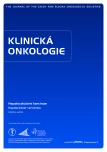Surgical treatment of hepatocellular carcinoma
Authors:
prof. MUDr. Třeška Václav, DrSc.
Authors‘ workplace:
Chirurgická klinika LF UK a FN v Plzeň
Published in:
Klin Onkol 2020; 33(Supplementum 3): 30-33
Category:
Review
doi:
https://doi.org/10.14735/amko20203S30
Overview
Surgical treatment of hepatocellular carcinoma (HCC) is part of multimodal treatment and consists of liver resection or transplantation. Unfortunately, only 30% of patients with HCC are primarily surgically treatable. The indication for surgery is based on the patient‘s biological condition, the extent of the disease, the function of the liver parenchyma and the residual volume of the liver. For liver resections, we choose anatomical resections. In case of insufficient residual volume of the liver, we have a possibility of staged procedures to increase the resectability of HCC. Liver transplantation solves not only the HCC itself, but also advanced underlying liver disease (cirrhosis) and is based primarily on the Milan indication criteria. The long-term results of surgical treatment depend on the progress of HCC. In HCC detected in the initial stage, the five-year survival of patients is 60–80%. In patients in whom radical resection or transplantation of the liver cannot be performed for various reasons, palliative methods, today mainly thermoablation, or transarterial chemoembolization or radioembolization are possible. In some patients, liver resection or transplantation can be performed after embolization.
Keywords:
resection – hepatocellular carcinoma – Transplantation – palliative surgery
Sources
1. Lin N, Li J, Ke Q et al. Does the intermittent Pringle maneuver affect the recurrence following surgical resection for hepatocellular carcinoma? A systematic review. PLoS One 2020; 15 (3): e0229870. doi: 10.1371/ journal.pone.0229870.
2. Yu J, Wu ZZ, Li T et al. Effectiveness of surgical resection for complicated liver cancer and its influencing factors: A retrospective study. World J Clin Cases 2020; 8 (4): 736–742. doi: 10.12998 /wjcc.v8.i4.736.
3. Kabir T, Tan ZZ, Chua DW et al. Early experience with laparoscopic liver resection for spontaneously ruptured hepatocellular carcinoma. J Minim Access Surg 2020; 16 (3): 239–245. doi: 10.4103/jmas.JMAS_4_19.
4. Yue YY, Zhou WL. Hepatic resection is associated with improved long-term survival compared to radio-frequency ablation in patients with multifocal hepatocellular carcinoma. Front Oncol 2020; 10 : 110–116. doi: 10.3389/fonc.2020.00110.
5. Huang F, Gao J. Modified Child-Pugh grade vs albumin-bilirubin grade for predicting prognosis of hepatocellular carcinoma patients after hepatectomy. World J Gastroenterol 2020; 26 (7): 749–758. doi: 10.374doi8/wjg.v26.i7.749.
6. Gentile D, Donadon M, Lleo A et al. Surgical treatment of hepatocholangiocarcinoma: a systematic review. Liver Cancer 2020; 9 (1): 15–27. doi: 10.1159/000503719.
7. Hou H, Zhou D, Cui X et al. Laparoscopic liver resection ameliorates the postoperative liver function impairment for hepatocellular carcinoma patients. Surg Laparosc Endosc Percutan Tech 2020; 30 (1): 69–73. doi: 10.1097/SLE.0000000000000749.
8. Mališ J, Jeřábková V, Koutecký J et al. Hepatocelulární karcinom u dětí. Klin Onkol 2001; 14 (1): 4–7.
9. Qi LN, Ma L, Chen YY et al. Outcomes of anatomical versus non-anatomical resection for hepatocellular carcinoma according to circulating tumour-cell status. Ann Med 2020; 52 (1–2): 21–31. doi: 10.1080/07853890.2019.1709655.
10. Forner A, Da Fonseca LG, Díaz-González Á et al. Controversies in the management of hepatocellular carcinoma. JHEP Rep 2019; 1 (1): 17–29. doi: 10.1016/j.jhepr.2019.02.003.
11. Madoff DC, Odisio BC, Schadde E et al. Improving the safety of major resection for hepatobiliary malignancy: portal vein embolization and recent innovations in liver regeneration strategies. Curr Oncol Rep 2020; 22 (6): 59. doi: 10.1007/s11912-020-00922-x.
12. Michal K, Sau M, Tamara GM et al. Better route to ALPPS: Minimally invasive vs open ALPPS. Surg Endosc 2020; 34 (6): 2379–2389. doi: 10.1007/s00464-020-07437-3.
13. Abreu P, Gorgen A, Oldani G et al. Recent advances in liver transplantation for cancer: The future of transplant oncology. JHEP Rep 2019; 1 (5): 377–391. doi: 10.1016/j.jhepr.2019.07.004.
14. Sánchez Segura J, León Díaz FJ, Pérez Reyes M et al. Predictive models of hepatocellular carcinoma recurrence after liver transplantation. Transplant Proc 2020; 52 (2): 546–548. doi: 10.1016/j.transproceed.2019.11.048.
15. Trunecka P. Liver transplantation – changes in indications over last decade. Vnitr Lek 2019; 65 (9): 588–594.
16. Trunecka P, Gerlei Z, Lisik W et al. Liver transplantation in central Europe. Clin Exp Hepatol 2016; 2 (1): 21–26. doi: 10.5114/ceh.2016.58853.
17. Henriksson M, Björnsson B, Sternby Eilard M et al. Treatment patterns and survival in patients with hepatocellular carcinoma in the Swedish national registry SweLiv. BJS Open 2020; 4 (1): 109–117. doi: 10.1002/bjs5.50226.
18. Polat KY, Acar S, Gencdal G et al. Hepatocellular carcinoma and liver transplantation: a single-center experience. Transplant Proc 2020; 52 (1): 259–264. doi: 10.1016/j.transproceed.2019.10.029.
19. Senkerikova R, Frankova S, Sperl J et al. Incidental hepatocellular carcinoma: risk factors and long-term outcome after liver transplantation. Transplant Proc 2014; 46 (5): 1426–1429. doi: 10.1016 / j.transproceed.2014.03.010.
20. Wu TH, Wang YC, Cheng CH et al. Outcomes associated with the intention of loco-regional therapy prior to living donor liver transplantation for hepatocellular carcinoma. World J Gastrointest Surg 2020; 12 (1): 17–27. doi: 10.4240/wjgs.v12.i1.17.
21. Jianyong L, Lunan Y, Dajiang L et al. Comparison of open liver resection and RFA for the treatment of solitary 3-5-cmhepatocellular carcinoma: a retrospective study. BMC Surg 2019; 19 (1): 195–201. doi: 10.1186/s12893-019-0663-9.
22. Zhao WJ, Zhu GQ, Wu YM et al. Comparative effectiveness of radiofrequency ablation, surgical resection and transplantation for early hepatocellular carcinoma by cancer risk groups: results of propensity score-weighted analysis. Onco Targets Ther 2019; 12 : 10389–10400. doi: 10.2147/OTT.S224809.
Labels
Paediatric clinical oncology Surgery Clinical oncologyArticle was published in
Clinical Oncology

2020 Issue Supplementum 3
Most read in this issue
- Hepatocellular carcinoma future treatment options
- Current treatment options for hepatocellular carcinoma
- Hepatocellular carcinoma – imaging methods and imaging guided therapy
- Hepatocellular carcinoma from the view of gastroenterologist/hepatologist
